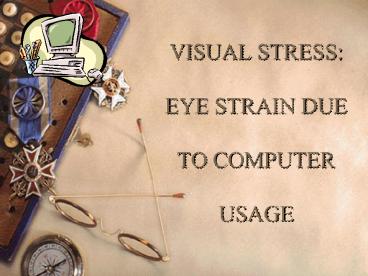VISUAL STRESS: EYE STRAIN DUE TO COMPUTER USAGE - PowerPoint PPT Presentation
1 / 33
Title:
VISUAL STRESS: EYE STRAIN DUE TO COMPUTER USAGE
Description:
an increase in the number and complexity of necessary eye movements and ... Monochrome monitors. Maximized resolution. Workstation Furniture and Arrangement. 30 ... – PowerPoint PPT presentation
Number of Views:183
Avg rating:3.0/5.0
Title: VISUAL STRESS: EYE STRAIN DUE TO COMPUTER USAGE
1
VISUAL STRESS EYE STRAIN DUE TO COMPUTER
USAGE
2
COMPUTERS AND VISION
- Dr. Marc Grossman
3
Computer Operators Experience Visual Stress due
to
- an increase in the number and complexity of
necessary eye movements and focusing skills - poor lighting conditions, glare and distracting
reflections - the extended amount of time spent on the computer
4
Computer Stress Checklist
- Direct symptoms
- Eyestrain
- Indirect symptoms The need for shifts in posture
and muscular strain resulting from poorly
arranged workstations
5
EYE STRAIN Symptoms (1/2)
- headaches while doing or following computer use
- irritated and/or dry eyes
- blurred vision
- slow refocusing when looking from screen to
distance objects - frequently losing place when moving eyes between
copy and the screen
6
EYE STRAIN Symptoms (2/2)
- difficulty in seeing clearly at a distance after
prolonged computer use - occasional doubling of vision
- changes in color perception
- lowered visual efficiency
- more frequent errors
7
Eye Strain Examination For Computer
- A general eye and health history
- the type of computer work
- the number of hours
- the time of day
- the size, type and color of your screen
- screen characters, positions
- the lighting in the room
8
Eye Strain Measurements For Computer
- the type severity and frequency of any symptoms
- A measurement of your visual acuity at distance
and near - A measurement of possible prescriptions for
distance and near working distances - An assessment of eye focusing ability
- An evaluation of eye coordination and eye
movement skills
9
Computer Use and Vision
Joan Comeau
10
OUTLINE
- INTRODUCTION
- CVS (Computer Vision Syndrome)
- GUIDELINE
- EXERCISES
11
Causes of CVS
- eye movements
- eye focusing
- eye alignment
12
Effects of CVS
- Tired and aching eyes
- Burning eyes
- Dry eyes
- Headaches
- Blurred vision
- Difficulty in focusing
- Double vision
13
Guideline
- 15 min. break every 2 hrs
- Eliminate reflections
- Use appropriate spots
- Appropriate screen position
- Visual exercises
14
Exercises and Eye Care
- Palming
- Drinking beverages
- Relaxation breaks
- Finger pressure and washing eyes
15
Eyestrain The number one complaint of computer
users
Rosemarie Atencio
16
CAUSES OF EYESTRAIN
17
Causes of Eyestrain
- Primary and Secondary Glare
18
Causes of Eyestrain
- Excessive Lighting
19
Causes of Eyestrain
- Improper Ergonomics
20
Causes of Eyestrain
- Poor Quality Video Display Terminals (VDT)
21
Causes of Eyestrain
- Uncorrected or Improperly Corrected Vision
22
Optometric Causes of Eye Strain and Ergonomic
Solutions
- Computer Vision Syndrome (CVS)
- Improving Visual Comfort at a Computer
Workstation - Visual Ergonomics In The Workplace
23
Symptoms of CVS
- Symptoms related to computer work are dose
related - Copmuter vs. Printed material
- lower contrast
- pixilated or aliased letters
- reading distance is often greater than 40 cm
- annoying reflections or glare off the screen
- monitors are usually higher than normal reading
material
24
Symptoms of CVS
25
Optometric Examination
- 1. Correct any distance refractive error.
- (Working distance, correct height, intermediate
zone, lens design) - 2. Correct any near refractive error.
- (Low plus lenses 0.75, etc.)
- 3. Test for binocular anomalies.
- 4. Evaluate for dry eyes.
26
Ergonomic Aspects
- 1. Lighting
- 2. Characteristics of the computer display
- (The smallest possible pixel size is preferable,
Contrast, Faster screen refresh rate) - 3. Work station design
- about 65 cm distance
- 10-20 degrees or 10-20 cm below eye level
27
Improving Visual Comfort at a Computer Workstation
- Lighting
- Screen Reflections
- Flicker Problems
- Display Characteristics
- Workstation Furniture and Arrangement
28
Improving Visual Comfort at a Computer Workstation
- Lighting
- Eliminate bright light
- Avoid white reflective surfaces
- Use indirect lighting systems
- Screen Reflections
- Use an antireflection screen
- cover the sources of the reflections
- Use dark characters on a light background
29
Improving Visual Comfort at a Computer Workstation
- Flicker Problems
- Display Characteristics
- Monochrome monitors
- Maximized resolution
- Workstation Furniture and Arrangement
30
Visual Ergonomics In The Workplace
- The Terminal
- Eye Position
- Glare
- Computer Glasses
- Vision Therapy
- Computer Vision Testing
- Eye Self-Care
31
Visual Ergonomics In The Workplace
- The Terminal
- Eye Position
- Paper 30-40 cm 40 degrees
- Monitor 20-25 cm below eye of sight
- Glare
- offices are much too bright for terminal work.
- Computer Glasses
32
Visual Ergonomics In The Workplace
- Vision Therapy
- Computer Vision Testing
- (VDT-related visual stress)
- on-line questionnaire
- vision tests
- Eye Self-Care
33
Eye Self-Care ("3 B's)
- Blink
- - normally 12-15 times a minute
- Breathe
- -relax the eye muscles
- Breaks
- -Micro-Break
- -Mini-Break
- -Maxi-Break































